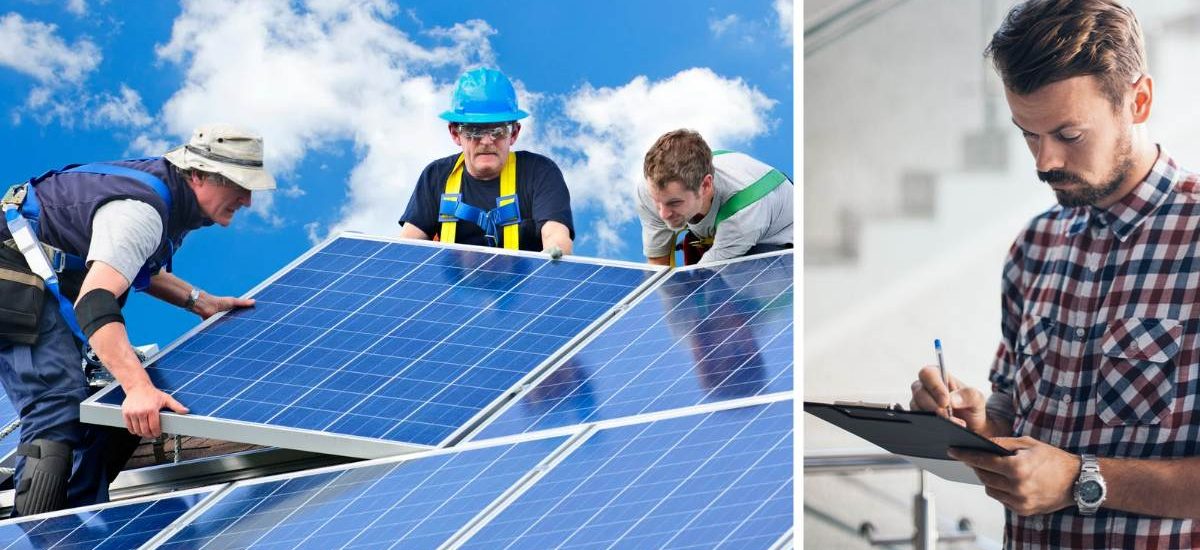


The solar site safety checklist includes safety equipment, site assessment, fall protection, electrical safety, and fire safety. If you want to become a solar panel installer, you need to follow the list by heart to ensure the installation of the PV systems is smooth, seamless, and without issues.
Contrary to popular opinion, solar installations are not as straightforward as you think, and not every home is suitable for solar panel installations. Not saying the process is complex and difficult, but it’ll best be done by a professional. There are certain things to consider for the installation process, and these items make up the solar site safety checklist.
You may consider it a buzzkill to have a list of items that need to be ticked before a solar system can be installed on your property, but when you look at the bigger picture, it’s to your advantage.
Firstly, the solar site safety checklist ensures the solar system is installed correctly without the risk of electrical hazards.
Secondly, it ensures that the potential installation site has all the necessary requirements for accommodating a solar system and is suitable for the project.
Thirdly, adhering to safety concerns on the checklist prevents avoidable issues that may occur with your solar power system after the installation has been carried out.
Lastly, you should do a solar site survey to ensure that nothing will impede or impair the performance or efficiency of the solar system.
Switching to renewable energy is a big, positive step because it amounts to significant carbon reduction on your part. Following the due process in solar installation honors the intent of switching to solar power in the first place.
We know that, at this point, you’re very curious about what the solar site survey checklist entails. Let’s take a look.

A standard solar site safety checklist will include the following:
This is the first and most important process. It’s when that particular location you intend to make the installation site passes the assessment that you can consider other elements. On the other hand, if the site fails the assessment, you won’t have to bother with the other elements.
As a homeowner interested in using a solar system for your energy needs, you’ll contact solar installers to survey your property and determine if it’s suitable for installation.
The site assessment takes note of site information such as the geographic location of the site, who owns the building, what type of building (commercial, industrial, or residential), the roof tilt or slope, the roof size, the roof type, and presence of obstructions or shading elements that will limit the sunlight exposure.
At this stage, the solar installers will determine if the solar panels will be installed on the roof or the ground.
It’s the job of the solar installer to follow safety precautions by ensuring that every worker involved in the project has their personal protective equipment. This includes safety gloves, hard hats to protect the head, safety glasses, high visibility clothing, safety toe footwear, and harnesses.
Having the safety equipment on is very important because it minimizes the risk of any unpleasant occurrence. If the solar installation is taking place on the rooftop (which is the most likely scenario), the workers will need to keep from falling. Make dust masks accessible as well. Without the safety equipment, the solar installer should not be allowed to continue.
All the workers involved in the solar installation must be well-versed in safety precautions regarding electricity. The solar system is an electrical system. If it’s a grid-tied system, they will also be working with the power lines.
If they’re trained electricians and are very familiar with electrical components as well as underground electrical lines, there will be less risk. Also, using safety gloves will protect them from electric shock, an incident that could be fatal at times.
Since most solar panel installations occur on the rooftop, the risk of falling must be significantly minimized or even eliminated. Not only should the workers have guardrails and harnesses to be appropriately grounded at the height they’ll be working at, but they should also have such equipment inspected to be sure it’s in top condition. This will prevent slipping.
Fire hazards are common in a fuel tank station. Still, they can also happen at a solar installation site due to faulty electrical wiring, even when the installer follows the manufacturer’s instructions. To ensure solar site safety, we recommend that fire extinguishers are present at the site.
Even though it’s not common, a worker can get injured during the installation process. For this reason, have first aid kits stocked to attend to this if it occurs.
This concerns regulations and guidelines pertaining to installing and maintaining PV systems. The purpose they serve is to protect the workers from the potential hazards that may happen when installing a solar system. Most of these regulations are provided by relevant authorities, including International Electrotechnical Commission, Underwriters Laboratories, and National Fire Protection Association.
The common solar panel safety standards include;
To draft a report using the checklist, do the following;
This depends on the site. A solar panel installer can complete the whole process within a few hours if it’s a residential property. On the other hand, if it’s an industrial property, it could take a few days, which means more than one visit.
The following makes a site good for solar installation;